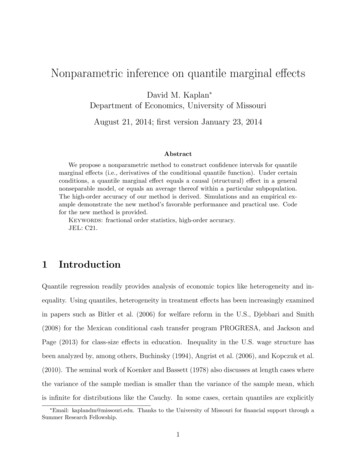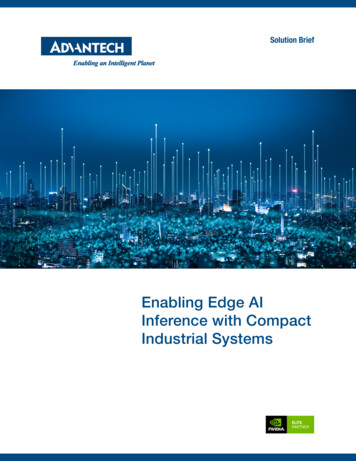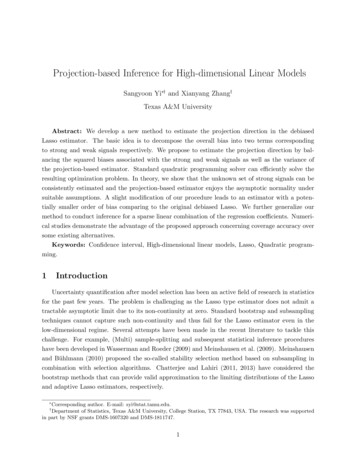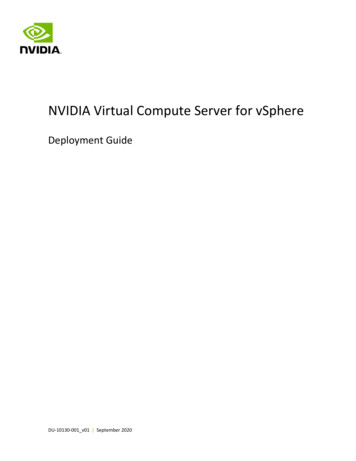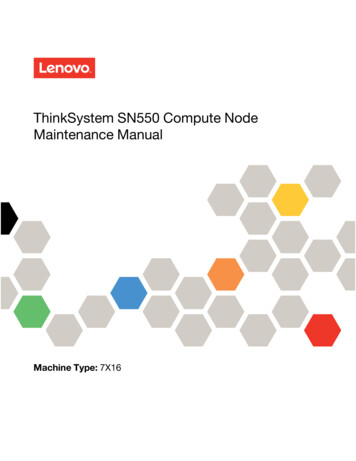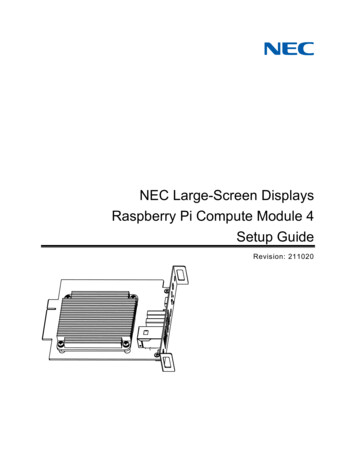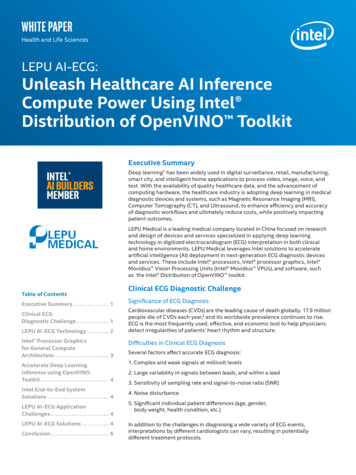
Transcription
white paperHealth and Life SciencesLEPU AI-ECG:Unleash Healthcare AI InferenceCompute Power Using Intel Distribution of OpenVINO ToolkitExecutive SummaryDeep learning¹ has been widely used in digital surveillance, retail, manufacturing,smart city, and intelligent home applications to process video, image, voice, andtext. With the availability of quality healthcare data, and the advancement ofcomputing hardware, the healthcare industry is adopting deep learning in medicaldiagnostic devices and systems, such as Magnetic Resonance Imaging (MRI),Computer Tomography (CT), and Ultrasound, to enhance efficiency and accuracyof diagnostic workflows and ultimately reduce costs, while positively impactingpatient outcomes.LEPU Medical is a leading medical company located in China focused on researchand design of devices and services specialized in applying deep learningtechnology in digitized electrocardiogram (ECG) interpretation in both clinicaland home environments. LEPU Medical leverages Intel solutions to accelerateartificial intelligence (AI) deployment in next-generation ECG diagnostic devicesand services. These include Intel processors, Intel processor graphics, Intel Movidius Vision Processing Units (Intel Movidius VPUs), and software, suchas the Intel Distribution of OpenVINO toolkit.Table of ContentsExecutive Summary . . . . . . . . . . . . . . 1Clinical ECGDiagnostic Challenge . . . . . . . . . . . . . 1LEPU AI-ECG Technology . . . . . . . . . 2Clinical ECG Diagnostic ChallengeSignificance of ECG DiagnosisCardiovascular diseases (CVDs) are the leading cause of death globally. 17.9 millionpeople die of CVDs each year,² and its worldwide prevalence continues to rise.ECG is the most frequently used, effective, and economic tool to help physiciansdetect irregularities of patients’ heart rhythm and structure.Intel Processor Graphicsfor General ComputeArchitecture. . . . . . . . . . . . . . . . . . . . . 3Difficulties in Clinical ECG DiagnosisAccelerate Deep LearningInference using OpenVINOToolkit. . . . . . . . . . . . . . . . . . . . . . . . . . . 41. Complex and weak signals at millivolt levelsIntel End-to-End SystemSolutions . . . . . . . . . . . . . . . . . . . . . . . . 4LEPU AI-ECG ApplicationChallenges. . . . . . . . . . . . . . . . . . . . . . . 4LEPU AI-ECG Solutions . . . . . . . . . . . 4Conclusion. . . . . . . . . . . . . . . . . . . . . . . 6Several factors affect accurate ECG diagnosis:2. Large variability in signals between leads, and within a lead3. Sensitivity of sampling rate and signal-to-noise ratio (SNR)4. Noise disturbance5. S ignificant individual patient differences (age, gender,body weight, health condition, etc.)In addition to the challenges in diagnosing a wide variety of ECG events,interpretations by different cardiologists can vary, resulting in potentiallydifferent treatment protocols.
White Paper LEPU AI-ECG: Unleash Healthcare AI Inference Compute Power Using Intel Distribution of OpenVINO ToolkitFigure 1. LEPU AI-ECG Multi-lead synchronous analysis.Image Courtesy of LEPU MedicalLimitation of Existing Diagnostic SoftwareLEPU AI-ECG TechnologyComputer programs for ECG analysis and interpretationwere introduced by various companies in the early 1970sand have become an essential tool for physicians over thelast 50 years.The combination of the availability of widespread digital ECGdata along with rapid advancements in AI computing powerand deep learning-based algorithm development offer anopportunity to rethink the traditional approach to ECG digitalsignal processing. The availability of these large ECG datasetsenables development of accurate deep learning basedmodels to allow efficient automated ECG interpretation.³Traditional diagnostic software is based on signal analysisof the morphology of P, QRS, and T waves. Clinicalinvestigations indicate that the accuracy of these softwarediagnoses is relatively low. For example: There are substantial rates of misdiagnosis by existingcommercial ECG interpretation algorithms.³ Only about 50% of non-sinus rhythms werecorrectly inferred.⁴ Only one out of seven presentations of seconddegree AV block were correctly recognized.⁵These diagnostic errors have limited the adoption oftraditional clinical computer-aided ECG interpretation.In research settings, convolutional neural networks (CNNs) ordeep learning algorithms have been applied to ECG analysisresearch. But these research efforts have mostly focused onvery limited diagnostic tasks, such as a handful of heartbeattypes (e.g., normal, ventricular, or supraventricular ectopic)and rhythm diagnostics (e.g., commonly atrial fibrillation orventricular tachycardia). At time of writing, there is no endto-end solution in the market like LEPU Medical’s Carewell*OmniECG with AI capabilities that can analyze raw ECG datacollected from standard 12-lead resting ECG and provide abroad range of clinical interpretations.Figure 2. Yellow highlighted area is the Gen9 ProcessorGraphics die area in Intel Core i7 6700K for desktop system.⁶The red dash line enclosed area depicts the SW/HW stack whichenables deep learning inference execution and optimizationon Intel Processor Graphics.⁷2
White Paper LEPU AI-ECG: Unleash Healthcare AI Inference Compute Power Using Intel Distribution of OpenVINO ToolkitTrained ModelImportIntermediaterepresentationof the modelMODEL OPTIMIZER.xml.binFP QuantizeReal-time DataValidation DataINFERENCE ENGINEMKL-DNNCPUModel Run-Time.prototxt.caffemodel3DLIAcIDNNFPGAIntel ProcessorGraphicsForwardHARDWARE UNITS PROVIDED BY INTELResultAPPLICATIONLOGICFigure 3. Deep Learning Network Model flows through the Deep Learning Deployment Toolkit.LEPU AI-ECG technology is a comprehensive deep learningbased analysis pipeline that provides synchronous automaticinterpretation of multi-lead raw ECG data. In 2018, LEPUAI-ECG became the first FDA 510(k)-cleared⁸ and CE-certifiedECG analysis software powered by AI in China (FDA 501(K):K180432; CE Certification: Q5 0500440 0027).Development of deep learning applications has beenincreasing due to the availability of good quality data andhigh-performance computing hardware. In many healthcareuse cases, there is a trend to perform AI inference at thenetwork edge driven by the need for low latency, localpersistence, reduced cost, and data privacy.“With overall accuracy of 95%, LEPU AI-ECG’s outstandingperformance and accuracy makes it a vital and irreplaceabletool for clinical physicians compared to traditional ECGsoftware,” stated Chinese cardiologist Dr. Qian Jianan, aformer editorial committee member of the Chinese Journalof Cardiovascular Medicine. “The feedback from the CommonStandards for Quantitative Electrocardiography (CSE)committee also indicated that LEPU AI-ECG performance isapproximately equal to the performance of the ‘average CSEcardiologist’ (all CSE referees are renowned cardiologists)and even outperforms the average cardiologist in severalcategories,” according to Mr. Liu Chang, the head of AI R&Dteam of LEPU Medical.There is a general misconception that AI inference on edgedevices must be done by discrete graphics processing units(GPUs). This paper shows that existing hardware or othernew forms of compute architecture may actually offer betterresults in terms of performance per watt and/or per dollar inspecific applications.Intel Processor Graphics for GeneralCompute ArchitectureIntel has a long tradition of democratizing computingcapabilities by making computing easier to use, morepowerful, and more accessible. For decades, Moore’s lawhas shown that shrinking transistors allows integratingmore features into silicon, while saving power andincreasing performance. The democratization of computecreates a sustained technological, economic, and societalimpact to daily life.Network CompilationPRIMITIVESconvConv relulrnfcpool. . .Intel Processor Graphics integrated with Intel system on achip (SoC) platforms have been shipped in more than a billiondevices ranging from servers to PCs to embedded devices.These on-die integrated GPUs (iGPUs) offer outstandingdisplay, media, and real-time 3D rendering performance.In addition to standard graphics features, the executionunits can support multi-threading, SIMD instruction sets forhigh-throughput floating-point, and integer general-purposecomputing at teraFLOPS performance levels.⁶ This generalpurpose compute capability helps to improve visual effectsfor photo editing applications, real-time volumetric 3Drendering, dynamic relighting in video feed computer visiontasks in OpenCV*, and more.CREATETOPOLOGYFROMPRIMITIVESNETWORKLEVEL OPTFigure 4. The clDNN Model flow from topology creation to execution.⁹MEMORYLEVEL OPTKERNELLEVEL OPTNETWORK READY TOEXECUTE
White Paper LEPU AI-ECG: Unleash Healthcare AI Inference Compute Power Using Intel Distribution of OpenVINO ToolkitIMAGES/SECThe Intel Deep Learning Deployment Toolkit, availablevia the Intel Distribution of OpenVINO toolkit, providesa unified API to unlock the AI inference capability ofvarious Intel hardware, such as CPUs, iGPUs, FPGAs,and VPUs. For iGPUs, the Deep Learning DeploymentToolkit is built on top of the Compute Library for DeepNeural Networks (clDNN), a library of OpenCL* kernels,to improve inference performance.Intel End-to-End System SolutionsIn addition to Intel Processor Graphics, the IntelDistribution of OpenVINO toolkit enables completeend-to-end deep learning inference solutions runningon Intel Movidius VPUs, Intel Pentium processors,Intel Celeron processors, and Intel Core processorsat the edge; Intel Xeon Scalable processors for intensivedata center-level processing; and Intel FPGAs for tailormade, high-performance acceleration. The OpenVINOinference engine allows execution of layers across thesedevices through heterogeneous hardware support.Systems that are designed based on Intel SoCs, systemfirmware, and software can also offer security features,such as Intel Software Guard Extensions (Intel SGX)and TPM, to protect data, algorithm, and other IPs frommisuse and theft. Intel also supports selected CPU andChipset SKUs with a prolonged lifecycle of 15 years tomeet the needs of the medical industry segment, as wellas other embedded devices.100BATCH 1BATCH 880604020CPUQ0HCore i7-67756l Intel Core i7-7-7607U0CPUCPUCPU00i5Core Intel Intel Pentium N420HQ7UIntel Core i7-67756-7i7Core Intel InteCPUCPUCPU060-7i5Core l Pentium N4200CPU0IntelclDNN includes highly optimized building blocks forimplementation of CNNs with C and C interfaces.The blocks include commonly used CNN primitives,such as convolution, pooling, normalization, activation,crop, deconvolution, and others.⁶ With the optimizedprimitive set, users can efficiently execute most commonimage recognition, semantic segmentation, and objectdetection networks, such as Alexnet*, Googlenet*,ResNet*, VGG*, and network topologies, includingU-Net*, RetinaNet*, FCN*, and others, for medical imaging workloads from MRI, CT, Ultrasound, and ECG.ResNet-50120InteAccelerate Deep Learning Inferenceusing OpenVINO Toolkit4Figure 5. Performance Numbers of ResNet-50 for integratedGPU in stated Intel SOCs. All Intel platforms are running withIntel Deep Learning Deployment Toolkit in Intel Distributionof OpenVINO toolkit.⁷To capture the hidden features in time series ECG signals,an FP32 (float point) or FP16 data type instead of INT8should be used to preserve the AI-ECG model precision in1D convolution and other deep learning topology primitives.Lower precision affects model accuracy. FP32 and/or FP16are supported by Intel processors, Intel Processor graphics,Intel Movidius VPUs and Intel FPGAs.The OpenVINO model optimizer provided out-of-boxoptimization for the LEPU’s AI-ECG CNN. LEPU Medicalported the AI-ECG model without needing to redesign,retrain, and retest the model for the above mentioned threeusage scenarios.Low latency, high throughput and minimal increase onsystem cost should also be considered equally importantwhen adopting any new AI system design.LEPU AI-ECG Application ChallengesLEPU AI-ECG SolutionsLEPU AI-ECG has three significant usage scenarios:Intel AI inference accelerators offer a solution to eachof LEPU Medical’s AI-ECG design challenges.1. Standalone ECG device2. On-premise ECG workstationAI-ECG Device3. In cloud-based ECG servicesLEPU Medical teamed up with Intel and designed thestandalone Carewell OmniECG* with AI-ECG poweredby an Intel Pentium N4200 processor with Intelprocessor graphics and leveraging the Intel Distributionof OpenVINO toolkit. This product will facilitate physicians in small or remote healthcare offices to performclinical ECG exams with outstanding performance andaccuracy. “There is an estimated increase in inferenceperformance by 40% and a reduction of board cost by30% compared with a previous design using an externalgraphics card, while retaining the same diagnosticaccuracy,” according to Mr. Liu.For AI-ECG in different form factors to function at peakperformance, a compatible AI reference computing engineis needed to deliver ECG analysis capabilities. However,most AI computing chip providers today offer custom SDKsto port pre-trained AI models into their own ecosystems,resulting in additional effort required to enable everyunique AI chip. This results in not only wasted time, butalso makes it difficult to migrate models onto a differenttarget platform.
White Paper LEPU AI-ECG: Unleash Healthcare AI Inference Compute Power Using Intel Distribution of OpenVINO ToolkitAI-ECG Workstation in HospitalsLEPU Medical conducted test trials of the CarewellAI-ECG* network in regional hospitals. It providedsimultaneous analysis of ECG signals collected fromdifferent clinical rooms within the hospital network.The LEPU AI-ECG on-premise workstation used in thishospital network is powered by an Intel Core i5 orIntel Core i7 processor with Intel HD Graphics.“This workstation design configuration delivers acompatible performance at a lower cost comparedwith a previous design using an external graphics card,”according to Mr. Liu. Table 1 lists the results forthese two solutions.AI-ECG Cloud ServiceThe LEPU AI-ECG cloud is designed to provide ECGdiagnostic services for various ECG products, includingresting ECG, Holter (ambulatory) ECG, event recorder,and wearables, such as Checkme Lite* (handy ECGdevice), EzCardio* (patch), LeCare* (band and watch),and others. Raw ECG data was uploaded to the cloud,and then analyzed and interpreted. The diagnosticresults can be downloaded to the clinical softwarein-hospital, or to mobile apps paired with wearableECGs. LEPU Medical teamed up with Intel to designa cloud-based inference system.The OpenVINO toolkit enabled the deployment ofall three scenarios with the same API, regardlessof which Intel compute solutions are used as theAI inference accelerator.AI-ECG InferenceSolution⁷PrecisionThroughput (FPS)Intel Pentium N4200 CPUFP3218.5Intel NCS2FP1624.0Intel HDGraphics 505FP3225.2Intel HDGraphics 505FP1625.7Intel Core i7-7700 CPUFP32109.5Intel HDGraphics 630FP16131.1Table 1: Intel Distribution of OpenVINO toolkit inferenceengine performance results running the LEPU AI-ECG workloads.Data courtesy of LEPU Medical in May 2019.10Figure 6. LEPU AI-ECG product ecology.Image courtesy of LEPU Medical.ConclusionNew clinical tools enabled by deep learning inference canassist and complement physicians in diagnostic workflowsand potentially improve patient outcomes. AI-poweredfeatures are expected to enhance next-generation ECGand patient monitor designs. By using the Intel Distribution of OpenVINO Toolkit for deep learning inference,LEPU Medical was able to achieve their goal of deploying“One AI-ECG Model that can run everywhere, from deviceto cloud.” This eliminated efforts to migrate and optimizeLEPU AI-ECG models for different designs and retainconsistent accuracy at better performance and cost.These achievements are a preliminary step in the development of end-to-end AI-ECG applications. There arestill a number of technical challenges in deploying the LEPUAI-ECG model to a practical clinical pipeline. These includelow power and cost on portable devices and high-throughputinference processing in the cloud. Intel teams will continueto work with LEPU Medical and other partners to make AItechnologies more accessible in healthcare applications.5
White Paper LEPU AI-ECG: Unleash Healthcare AI Inference Compute Power Using Intel Distribution of OpenVINO ToolkitAbout LEPU MedicalAbout IntelScience and Technology Cherish Life.Intel Makes Possible the Most AmazingExperiences of the Future.As the forefront innovative medical device manufacturer in China,LEPU medical develops high-tech medical devices and equipmentspecialized in fields of cardiovascular interventions, structuralheart diseases, cardiac rhythm management, anesthesia andcritical care, in-vitro diagnostics, and general surgery. We arededicated to our mission of revolutionizing medical equipment.From the first coronary stent in China to the first bio-absorbablestent in 2019, LEPU Medical has produced more than 60 millioncardiovascular medical products in the last 20 years, andabout 3 million coronary heart disease patients have benefitedfrom our products and services. Our work never stops and weare constantly researching and developing new products andtechnology to bring better medical services to the world. LEPUMedical is a pioneer in AI- Medical research and development,prompting AI-ECG to aid clinical physicians in ECG diagnosis andinterpretation more accuracy and efficient.6You may know us for our processors. But we doso much more. Intel invents at the boundaries oftechnology to make amazing experiences possiblefor business and society, and for every personon Earth. Harnessing the capability of the cloud,the ubiquity of the Internet of Things, the latestadvances in memory and programmable solutions,our rich portfolio of AI technologies, and the promiseof always-on connectivity, Intel is disrupting thehealth and life sciences industry and helping solvethe toughest challenges.Lepu Medical is a member of the Intel AI Builders Program, an ecosystem of industryleading independent software vendors (ISVs), system integrators (SIs), original equipmentmanufacturers (OEMs), and enterprise end users, which have a shared mission to acceleratethe adoption of artificial intelligence across Intel platforms.Intel does not control or audit third-party benchmark data or the web sites referenced in this document. You should visit the referenced web site and confirm whether referenced data areaccurate. Cost reduction scenarios described are intended as examples of how a given Intel- based product, in the specified circumstances and configurations, may affect future costs andprovide cost savings. Circumstances will vary. Intel does not guarantee any costs or cost reduction.LEPU legal: LEPU Medical, the LEPU Medical logo, Carewell, EzCardio are trademarks of LEPU Medical Corporation or its subsidiaries in China and/or other countries. LEPU Medical haseffectively registered and applied for the relevant intellectual property rights of AI-ECG. The intellectual property rights owned by LEPU Medical for AI-ECG are protected by law.LEPU Medical disclaims all express and implied warranties whatsoever, including without limitation, the implied warranties of merchantability, non-infringement and fitness for any particularpurpose. Further, LEPU Medical will not be liable for any direct, indirect, special, incidental, punitive, or consequential damages of any kind. LEPU Medical has used various resources legally andprudently to edit and publish this white paper on its professional knowledge. The white paper information is only used to display and introduce products, but does not express or imply representations or warranties in terms of the completeness and updateability of the content. LEPU Medical is not responsible for damage or injury resulting from the use or dependence on the information provided in this white paper. Please note: The data, opinions, or other information set forth in this white paper are accurate at the date of its publication but not continuously updated.Unauthorized use, copying and provision to third parties of the above intellectual property rights (including but not limited to documents, illustrations, data, etc.) for any commercial purposeis prohibited. Otherwise, the right holder has the right to pursue legal responsibility for the acts and persons which invade industrial property. Any legal claims or actions relating to this whitepaper shall be accordance with the laws of the People's Republic of China.Optimization Notice: Intel's compilers may or may not optimize to the same degree for non-Intel microprocessors for optimizations that are not unique to Intel microprocessors.These optimizations include SSE2, SSE3, and SSSE3 instruction sets and other optimizations. Intel does not guarantee the availability, functionality, or effectiveness of any optimizationon microprocessors not manufactured by Intel. Microprocessor-dependent optimizations in this product are intended for use with Intel microprocessors. Certain optimizations not specificto Intel microarchitecture are reserved for Intel microprocessors. Please refer to the applicable product User and Reference Guides for more information regarding the specific instructionsets covered by this notice. Notice Revision #20110804.Intel technologies’ features and benefits depend on system configuration and may require enabled hardware, software or service activation. Performance varies depending on systemconfiguration. No computer system can be absolutely secure. Check with your system manufacturer or retailer or learn more at intel.com.Intel disclaims all express and implied warranties, including without limitation, the implied warranties of merchantability, fitness for a particular purpose, and non-infringement, as wellas any warranty arising from course of performance, course of dealing, or usage in trade.¹ Artificial intelligence (AI), machine learning, and deep learning are used interchangeably in this paper. The larger field is artificial intelligence. This article focuses on the machine learningpiece of AI, or more specifically, the multi-layered neural networks form of machine learning called deep learning.² WHO, “Cardiovascular diseases,” [Online].Available: https://www.who.int/cardiovascular diseases/en/³ P. Rajpurkar, A. Hannun, M. Haghpanahi, C. Bourn and A. Ng, “Cardiologist-Level Arrhythmia Detection with Convolutional Neural Networks,” Nature Medicine, p. 65, 1 2019.⁴ A. P. &. R. S. A. Shah, “Errors in the computerized electrocardiogram interpretation of cardiac rhythm.”, J. Electrocardiol, p. 385–390, 2007.⁵ M. E. &. T. D. Guglin, “Common errors in computer electrocardiogram interpretation,” Int. J. Cardiol, p. 232–237, 2006.⁶ “The Compute Architecture of Intel Processor Graphics Gen9,” [Online].Available: pdf⁷ “Accelerate Deep Learning Inference with Integrated Intel Processor Graphics Rev 2.0,” [Online].Available: rocessor-graphics-rev-2-0⁸ FDA, “510(k) Premarket Notification,” [Online].Available: /cfpmn/pmn.cfm?ID K180432⁹ “clDNN Documentation,” [Online].Available: https://intel.github.io/clDNN/index.html10All system configurations run with Ubuntu 16.04 LTS x86 64 and Intel Distribution of OpenVINO toolkit (2018.5.455) with LEPU Medical ECG workloads (see FPS for details).Precision: Post training execution precision used in OpenVINO inference engine.Throughput: FPS, Frame per second. A frame is a complete input sequence (ECG data sampled at 250Hz and the duration is implementation specific) sent to LEPU AI-ECGinference engines. Higher number means better performance.N4200/FP32, HD Graphics 505/FP32 & FP16: System Configuration: Intel Pentium N4200 with HD Graphics 505, 4G of System RAM.Intel Neural Compute Stick 2 (Intel NCS2): System Configuration: Intel Neural Compute Stick 2 (NCS 2) on System Configuration used in N4200/FP32.Intel Core i7-7700/FP32, Intel HD Graphics 630/FP16: System Configuration: Intel i7-7700 with HD Graphics 630, 16G of System RAM.Intel, the Intel logo, Movidius, OpenVINO, Pentium, Celeron, Intel Core, and Xeon are trademarks of Intel Corporation or its subsidiaries in the U.S. and/orother countries.* Other names and brands may be claimed as the property of others. 2019 Intel CorporationPrinted in USA0719/BA/HBD/PDFPlease Recycle340932-001
Large variability in signals between leads, and within a lead 3. Sensitivity of sampling rate and signal-to-noise ratio (SNR) 4. Noise disturbance . White Paper LEPU AI-ECG: Unleash Healthcare AI Inference Compute Power Using Intel Distribution of OpenVINO Toolkit Figure 5 . Performance Numbers of ResNet-50 for integrated GPU in stated .


